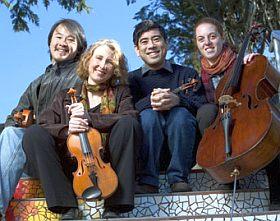
Every piece on the program was introduced either by various members of the string quartet or by the composers themselves. The preconcert chat was neither pretentious nor too informal, and the words illuminated the music with genuinely heartfelt stories and descriptions.
Linda Catlin Smith’s Gondola (2007), her fourth string quartet, opened the concert with the gentlest of melodies in unison, notated a 16th note apart for each of the players. Ordinarily this would be extremely difficult to execute, or would end up sounding jerky. Yet the Del Sol poured forth the music in a steady stream, and the slight offset mimicked the gentle lapping of water in the nearby marina. Out of this calming texture, the cello line diverged from the group to play an earnest melody, to the accompaniment of quietly spattering pizzicato, like a boat floating through still waters. The cello solo was played clearly and movingly by Hannah Addario-Berry, who provided a sturdy but agile bass foundation for the entire evening.
After this introduction came two premieres. Both composers related that their ethnic and familial roots were the source of inspiration. The composers looked deep within themselves and their life experiences to create this music — music that was beautiful and tonal, which didn’t preclude it from sounding undoubtedly original, full of contemporary relevance.
Paul Yeon Lee’s Ari, Ari... ari consists of a theme and variations on the famous Korean folk song Arirang. Lee, born in Korea in 1970, was inspired by childhood memories of his grandmother singing out of tune in a hoarse, wavering voice. Aptly, he assigned the opening melody to the upper C string on the viola. Charlton Lee infused the melody with stunning coloristic effects: slightly ponticello raspiness, combined with an ultrawide vibrato and emotive slides along the fingerboard in a region of the viola that’s rarely employed.
The resulting sound immediately transported the listener to the Far East, though in a genuine way, completely avoiding Orientalist cliché, surely due in part to both the composer and the performer being of Asian origin. The quartet moved though a dramatic array of variations, with bits of the original Arirang melody always recognizably wavering between foreground and background.
Born in Cuba in 1942, Tania León premiered her String Quartet No. 1, which was inspired by childhood memories of her own grandmother. Her piece is full of Caribbean rhythmic vitality and a tropical, lush sound. My ear yearned for a pair of congas and a marimba to go with the Latin texture.
Master Glass Work
Rounding out the evening was Philip Glass’ Fifth String Quartet. Despite being only 28 years old (in the world of classical music, especially with string quartets, that’s very young indeed), the piece has a distinctly dated feel. But that’s not to say that it has lost its freshness and emotional relevance. Glass already feels like one of the old masters, having created his own distinct and unmistakable sound. He’s an established fact of the overall repertoire — a chapter all his own in music history.The Fifth String Quartet is one of the finest examples of the composer’s works. It includes his signature rhythms and harmonies, though with surprises at every turn. Each slight delay, each shift in the rhythmic lattice makes a thrilling, interesting disruption in the groovy mix of the lively patterns. The endless stirring and shimmering goes on for an uninterrupted 20-plus minutes and seems taxing on the players. Yet the Del Sol churned out the piece with dazzling energy.
The Del Sol String Quartet has a saying: “You can’t e-mail Beethoven.” Its commitment to new music is essential to keeping our classical music community living and breathing, with current composers who write from the depths of their soul as well as the profundity of their brain. The Del Sol serves this mission with a unified and sincere group sound, with full participation from all; entirely absent is the old quartet-aesthetic of “first violin plus helpers.” As a result, its playing is a sum of four vivid parts, with each element liable to rise at any time to take the center, and then to meld back into the group.
The Del Sol made a handsome sound in the Presidio’s Main Post Chapel, an excellent venue for chamber music. It offers just the right level of intimacy, and, despite being long and narrow with parallel walls, there’s not too much reverberation, especially with a full, warmly receptive audience there to appreciatively soak up the sound.

